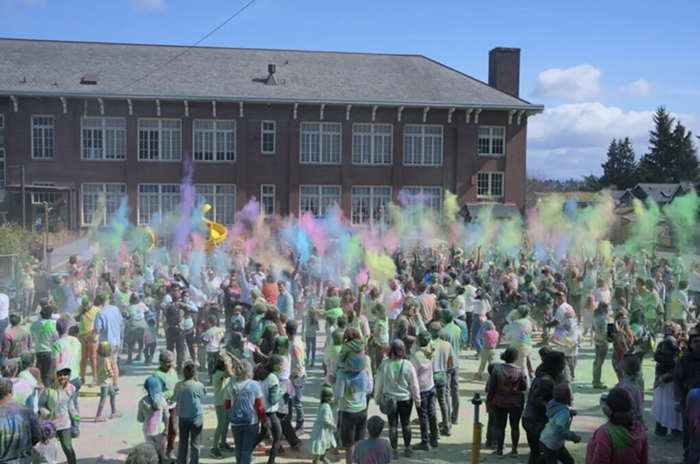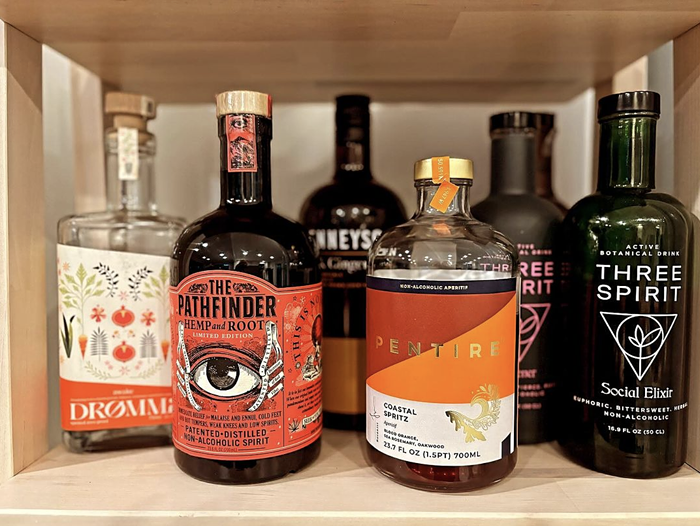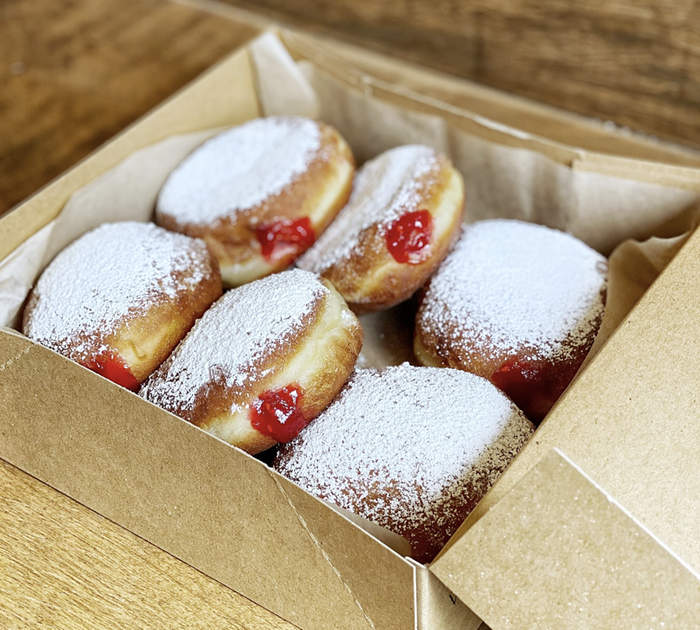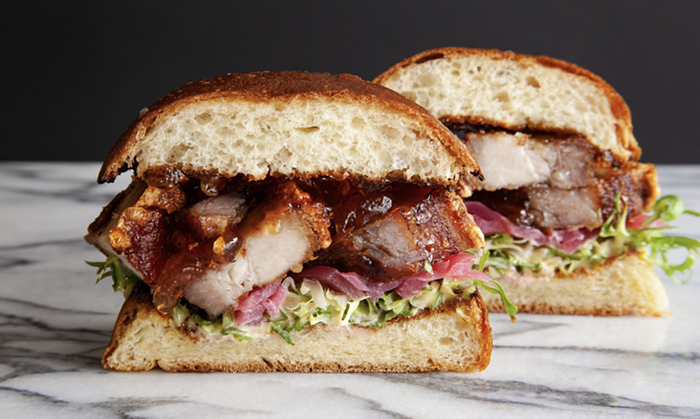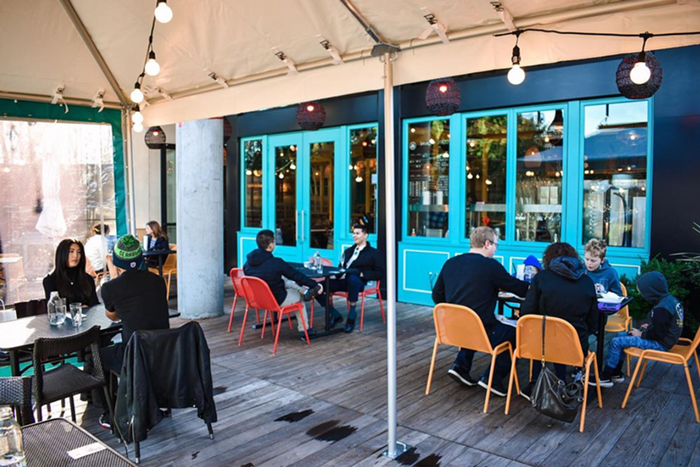Long before Wassef Haroun and his wife, Racha, opened their first restaurant, Mamnoon, in 2012, Wassef spent years working at the Microsoft campus in Redmond. Lunch was often two pieces of presliced cafeteria pizza eaten at his desk.
"At the time, I didn't know much better, and didn't have much choice," Haroun recalls.
The Harouns just opened a second version of Mamnoon, called Mamnoon Street, in downtown Seattle's brand-new, 36-story Doppler office tower, the first of three high-rise buildings being constructed as part of Amazon's global headquarters and urban campus.
The kitchen at Mamnoon Street, which is visible to anyone walking along Sixth Avenue, is in constant motion: Chicken and lamb slow roast on a spit before being shaved off for shawarma; herbs are chopped for quinoa tabbouleh; falafel is fried to order; and freshly baked flat breads called manaeesh are sprinkled with fragrant za'atar. The intoxicating smells of smoke, garlic, sumac, and mint commingle and fill the air. These are the flavors of the Harouns' native country, Syria, as well those of Lebanon, and other areas of the Middle East.
The restaurant's defining feature is a smartly designed walk-up window, outfitted with gleaming white subway tiles and a heating lamp. At noon on even a cold and rainy day, it's easy to see why the line of people waiting is 12 deep. You can take your food to go, or eat it in a small dining room and bar warmed by orange chairs and the frenetic energy of the walk-up window.
The Harouns are among a group of local restaurateurs who signed on with Amazon, a number that will grow over the next two years. They have not one but two restaurants on the ground floor of Doppler. The other is Anar, tucked into the interior of the block, away from the street, which eschews meat, dairy, gluten, or processed sugar. It's a calm oasis decorated in Moroccan tiles, and its menu is steeped in Middle Eastern flavors, but with a decidedly healthy focus. There are house-made fruit-and-vegetable juices with ingredients such as rosewater, orange blossom, and pomegranate, as well as bowls filled with quinoa, kale, muhammara, green lentils, and pickled turnips. It's crave-worthy food that also happens to be good for you.
And those are just two of the many restaurants on this brand-new block, bordered by Sixth and Seventh Avenues, and Lenora and Virginia Streets, which didn't exist a few months ago. (It used to be a blue-gray motel and parking lot.) The ground floor of Doppler offers an undeniable variety of cuisines, price points, and culinary techniques. The tower and its adjacent Meeting Center comprise more than one million square feet of office space.
Haroun admits that when he and his wife were initially approached by Real Retail, the real-estate company hired by Amazon to manage retail leases throughout its new buildings, about opening a restaurant in Doppler, they were skeptical.
"Our first reaction was, 'Ooh, a corporate campus, that feels really tied into one company,'" he says, pulling air in between his lips and grimacing slightly for emphasis.
The Harouns were not sure if their vision would be a good fit with Amazon's.
"Our aim is always to have the broadest possible set of guests," he says. "At Mamnoon, on any given night, we have an unbelievably diverse set of guests—all walks of life, races, religion. That's really something to be very proud of. And so we needed to learn more about it."
Haroun believes diversity, and a growing awareness of food, is taking root in the tech workforce. "On the campus of Microsoft, you won't see that many women. Here you do—at least more than I ever remember seeing."
He went on to say, "Technology is, more and more, a part of our everyday lives—and every part of our lives. [Techies] are no longer these strange people just thinking about algorithms and abstract things, especially at Amazon."
At Bar Noroeste, a restaurant conceived by Josh Henderson, executive chef and founder of the Huxley Wallace Collective, the kitchen, led by chef Shannon Martincic, aims to answer the question "What if tacos originated in the Northwest?"
At the heart of Noroeste's menu are tacos made with ingredients sourced almost entirely from the Pacific Northwest, like fresh lingcod caught off the Washington Coast, thick tortillas made from yellow corn grown on the Olympic Peninsula, and Oaxacan cheese made from Jersey cow milk in Oregon. But you can also sit down to a prix-fixe meal that begins with scallop ceviche—cool, sweet meat marinated in a bright pisco-cilantro sauce, topped with spiced popcorn and lovely, delicate almond blossoms—as well as venison crudo, dark and muscular, flavored with fermented almonds and crispy fried shallots. Your meal ends with a server smashing a piñata constructed from Theo chocolate, made at the company's factory in Fremont, onto your table.
Avocados do not grow in the Northwest, and one of the more talked-about aspects of Bar Noroeste's cooking is how they get around this particular situation. Noroeste's guacamole is made not from avocados but from eggplants that are soaked whole in a mixture of soda water and salt before being fried and peeled. This technique alters the flesh of the eggplant, giving it a texture that strives toward the richness of raw avocado. Cilantro and garlic give the "guacamole" its flavor and familiar green color.
As for the "chips," they are made from red wheat berries instead of corn; the grains are ground in-house, then formed into chips, and fried.
At first bite, Noroeste's green spread did taste like guacamole, though it was airy, not dense and buttery, the characteristic traits of great guacamole. But with each bite, my tongue and my brain went back and forth, holding their own excited discussion about experience versus expectation. The dish played with my perceptions of texture and flavor, making me appreciate the skill and risk behind the food.
On a more recent visit to the Doppler building, I tried Bar Noroeste's guacamole for a second time. The chips were the same—grainy and dense, almost like pieces of savory graham cracker crust that had been deep-fried into greasy, tasty submission. But the guacamole itself was dramatically better, creamier. I'm not sure that I'll ever truly accept it as guacamole, but I admire its existence.
Amid a Seattle culinary landscape that values local ingredients, the question at the heart of Noroeste's cooking is more inevitable than surprising. But it's also a question predicated on a certain amount of hubris. The taco and its base, masa, which is made from a crop indigenous to the pre-Columbian Americas, were already invented many years ago.
But what aspect of Amazon's increasing global and urban dominance doesn't contain some element of hubris? Every table at Bar Noroeste is a window seat, and the windows to the north look directly into three interlocking steel-and-glass biospheres that, while currently under construction, have already captivated the imagination and affection of many Seattleites.
When they're completed next year, the biospheres will be up to four stories high and big enough to accommodate plants, including mature trees, from high-elevation climates from around the world. Amazon will employ a full-time horticulturist, and there will be restaurants on the ground floor of these structures, too. Conceived as a workplace with "restorative qualities that are not found in the typical office," the biospheres themselves may or may not be open to the public. Whether you or I will be able to encounter the natural beauty within them remains to be seen.
Meanwhile, if you look out Bar Noroeste's east-facing windows, past the aquamarine scaffolding-esque structure that frames Noroeste's doorway, you'll see a pristine, recently installed bike path running along Seventh Avenue. Just behind that, a building that feels decidedly less contemporary and clean: Little Darlings, an "intimate gentleman's club in the heart of Seattle," right next to the sex shop Fantasy Unlimited.
While you think about the new-Seattle-meets-old-Seattle view, a steady stream of Amazon workers, signature blue work badges dangling from their necks and waists, pass by Noroeste's windows. All seats at Noroeste are within arm's reach of an electrical outlet should you need to charge one or more of your devices, a feature many diners take advantage of.
It seems fitting that a restaurant looking to push beyond an already rich cultural tradition is housed inside the headquarters of a company that is now aggressively attempting to redefine what the heart of Seattle looks like, and what it means to live, work—and eat—here.
Most of the restaurants in the Doppler tower opened in January, a few weeks after the first Amazon workers began occupying the offices above. Henderson and Huxley Wallace also opened a decidedly different concept, Great State Burger, in a space adjacent to Bar Noroeste but with a completely different design scheme. Bar Noroeste looks like a small and sleek cocktail lounge awash in dark wood with gold and turquoise accents. Great State Burger, by contrast, is all blond wood and bright colors.
Great State is a Pacific Northwest take on the classic American burger joint: grass-fed beef, fresh crinkle-cut fries, organic milkshakes, and locally brewed beers, all served in compostable packaging.
When planning these concepts, Henderson says, "The question was always about the Amazon customer and how it would work with them." With Great State, they focused on "speed, efficiency, and value," and with Noroeste, they created an environment appropriate for lingering over "a cocktail and some highly curated food—whether that's a long out-of-office lunch, happy hour, or after-work drinks and dinner."
As Haroun pointed out, one of the things about the Doppler project that appealed to him was that, unlike the Microsoft campus, Amazon's campus is being "designed with a relatively limited capacity cafeteria, to encourage people to spread out, participate with, and get food from the community."
Mamnoon Street, Anar, Bar Noroeste, and Great State Burger represent just the beginning of what is available on the street level of the Amazon campus. Also open already is the Hawaiian-inspired Marination, from Kamala Saxton and Roz Edison, who also own the food truck Marination Mobile, Capitol Hill's Marination Station, West Seattle's Marination Ma Kai, and Columbia City's Super Six. This new location serves popular Marination dishes like miso-ginger chicken or "sexy tofu" tacos, as well as sliders stuffed with kalua pork or Spam, and new dishes such as a Korean cheesesteak sandwich with kalbi beef. Marination isn't set up for a leisurely lunch: Seating consists of mostly bar stools and counter space lining the windows and looking out onto the corner of Sixth Avenue and Virginia Street.
Doppler is also home to Skillet Regrade, the fourth location of Skillet Diner, serving comfort food (including a crazy-good fennel-seed-crusted fried chicken sandwich that's slathered with a pickled and charred jalapeño aioli). Additionally, there's an outpost of the national Potbelly Sandwich Shop chain and a Starbucks.
Cinque Terre, an Italian restaurant from the Varchetta family, who also own and operate Barolo downtown and Mamma Melina in the University District, is scheduled to open shortly, with an emphasis on local seafood. And according to a sign that's wrapped around a vacant corner space on the corner of Sixth Avenue and Lenora Street, retail opportunities at Doppler—and the other Amazon buildings—are still available.
The website of Real Retail promises that Amazon's urban campus "will be the largest development downtown Seattle has ever seen."
The concept—and scale—of Amazon's urban campus is something entirely new to Seattle. Like Microsoft, the company could have set up a sprawling campus in Redmond or another city on the Eastside, but instead deliberately chose to build within the city.
Currently, Amazon holds over eight million square feet of office space across more than 30 buildings, most of them concentrated in South Lake Union. Once construction of the urban campus is complete (likely in 2018), there will be approximately 10 million square feet of office space accommodating up to 55,000 employees in the center of the city, according to the company.
Amazon also wants its urban campus to be environmentally friendly, so it will use recycled energy given off by computers and servers in a nearby data center to heat its buildings. "We'll have the world's largest internet retailer heating its office space with waste heat created by the internet," Richard Stevenson, president of Clise, which owns the data center building, told the Seattle Times.
Amazon is also a dog-friendly workplace; Doppler is home to a rooftop dog park.
More than 70 percent of Amazon employees live in the city itself and, according to an employee survey, just over half of them walk, bike, or use public transportation to get to their offices. The company purchases ORCA cards for its workers to encourage the use of mass transit. Amazon-built cycle tracks, like the one you can see from Noroeste, are one of the public benefits required by the city of Seattle in exchange for selling its street-use rights to Amazon. This process, called an alley or street vacation, requires the buyers to pay market value for the space and provide long-term benefits to the general public.
According to a vacation petition filed with the city last year, market value in downtown Seattle was $600 per square foot. Amazon paid approximately $3.4 million for 5,756 square feet for a private right-of-way granted by the city for the block between Seventh and Eight Avenues and Bell and Blanchard Streets. In exchange, the company will build a hill-climb area with trees and outdoor seating, more cycle tracks, and setbacks to buffer pedestrians from street traffic.
Amazon set the Doppler building far back from the street to create a more pedestrian-friendly sidewalk, which translates to a more eater-friendly sidewalk. Haroun says that that extra space is what made Mamnoon Street's walk-up window possible, and what will allow them to build an outdoor dining area for warmer weather, as Skillet Regrade has already done.
Careful planning and vision are what eventually drew the Harouns into the Doppler project. They see it as an opportunity to bring energy and diversity into an area of the city that previously languished. This is only two blocks north of Pacific Place, and yet this area used to be seriously deprived of dining options.
"It's starting from scratch, and we have an opportunity to shape it in a way that, frankly, the city missed doing in other parts of downtown," Haroun says. "We were excited, not just to participate for our own interests, but because we felt, over time, this could be pretty interesting for the whole city."
For now, the Harouns' immediate concern is attracting diners to their restaurants after traditional business hours—after Amazon's employees have left the building. By offering happy hour at Mamnoon Street, the Harouns are "trying" to stay open until 9 p.m. The restaurants get a decent number of guests on Saturdays, but there aren't many people on Sundays.
On a recent Saturday night at 6:30 p.m., a stroll past Bar Noroeste confirmed it was less than half-full. The same was true of Great State, which may just be because the building is new and people are not used to thinking of this part of downtown as a restaurant neighborhood.
"At some point, we will sit down with the building and figure out if, long-term, this is going to grow in the way we want," says Haroun.
"Those of us who love and care for this city should encourage growth and change, but do it in a way that can be managed and produce the outcomes we want to see."

